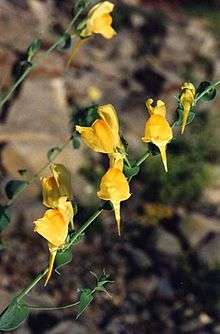Linaria dalmatica
Linaria dalmatica is a herbaceous plant native to western Asia and southeastern Europe that has become a weed in other areas. Its common names include Balkan toadflax, broadleaf toadflax, and Dalmatian toadflax.[1]
| Linaria dalmatica | |
|---|---|
 | |
| Scientific classification | |
| Kingdom: | Plantae |
| Clade: | Tracheophytes |
| Clade: | Angiosperms |
| Clade: | Eudicots |
| Clade: | Asterids |
| Order: | Lamiales |
| Family: | Plantaginaceae |
| Genus: | Linaria |
| Species: | L. dalmatica |
| Binomial name | |
| Linaria dalmatica | |
| Synonyms[1] | |
| |
Invasive species
Linaria dalmatica is listed as a noxious weed in 12 U.S. states.[2] It is a grassland invader native to the Mediterranean region, and it was introduced to North America in the late 1800s. It has fast-growing strong, horizontal roots, and can withstand cold, and is a problem for farms and grasslands in the interior of British Columbia.[3]
NATIVE TO/ WHEN INTRODUCED: Mediterranean region of Europe, Dalmatian toadflax is currently found in at least 34 states in the U.S. and most of the Canadian provinces. Has significantly reduced livestock production on infested pastures and rangeland. The first records of the species in Washington date back to the 1920s.
HOW/WHY INTRODUCED: Cultivated as an ornamental, for use in fabric dye, and for medicinal purpose
WHAT IMPACT: Dalmatian toadflax has no value as food, and crowds out valuable forage. The plants are reported to contain an iridoid glucoside and may be harmful to livestock. (though poisoning is rare because animals often avoid it)
Life Cycle: Dalmatian toadflax is a perennial with extensive roots that grow up to 3 feet tall and spreads by seed and lateral roots. The overall form of the plant is narrow and upright, with multiple stems growing from a single woody base. Snapdragon-type flowers are bright yellow tinged with orange and are 1 to 1.5 inches long. Seed pods, flowers and flower buds are often present at the same time. Plants have a long flowering period, generally May to August. Mature plants can produce up to 500,000 seeds and seeds remain viable in the soil for up to 10 years.
Control: Isolated plants can be dug up fairly effectively if the soil is not too hard or rocky. However, roots tend to break off and new shoots will re-sprout from any remaining lateral roots. Make sure to follow up at the site for at least a few years to watch for re-growth from the roots and emerging seedlings. If plants are in seed, carefully bag and cut off the stems before digging up the roots to minimize seed dispersal. Maintaining a healthy stand of grasses and other species will help prevent the spread of toadflax since it is most competitive in sparsely vegetated areas. Toadflax is not generally a problem in cultivated areas as regular tillage will control it.
Chemical control of toadflax can be difficult. Spraying should be done in late spring when plants begin to flower or in the fall before the plants die back. Wet all foliage thoroughly but not to the point of running off the plants
References
| Wikimedia Commons has media related to Linaria dalmatica. |
- "Linaria dalmatica". Germplasm Resources Information Network (GRIN). Agricultural Research Service (ARS), United States Department of Agriculture (USDA). Retrieved 2011-02-15.
- "USDA PLANTS database".
- "Dalmatian Toadflax, Aliens Among Us". Archived from the original on 2013-12-13. Retrieved 2013-12-13.
External links
- Species Profile- Dalmatian Toadflax (Linaria dalmatica), National Invasive Species Information Center, United States National Agricultural Library.